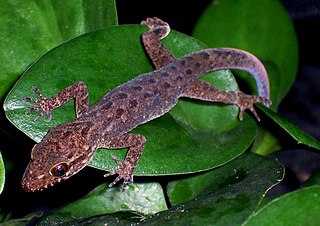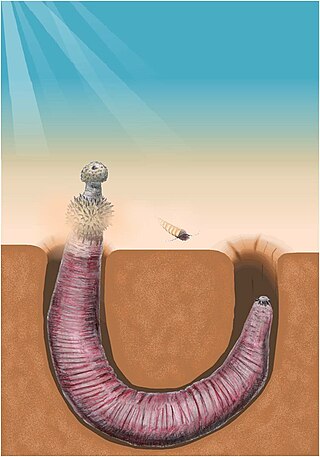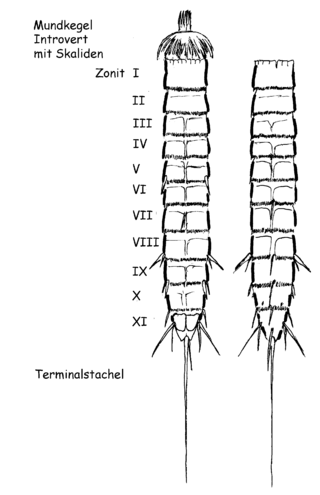
Priapulida, sometimes referred to as penis worms, is a phylum of unsegmented marine worms. The name of the phylum relates to the Greek god of fertility, because their general shape and their extensible spiny introvert (eversible) proboscis may resemble the shape of a human penis. They live in the mud and in comparatively shallow waters up to 90 metres (300 ft) deep. Some species show a remarkable tolerance for hydrogen sulfide, anoxia and low salinity. Halicryptus spinulosus appears to prefer brackish shallow waters. They can be quite abundant in some areas. In an Alaskan bay as many as 85 adult individuals of Priapulus caudatus per square meter has been recorded, while the density of its larvae can be as high as 58,000 per square meter.

Kinorhyncha is a phylum of small marine invertebrates that are widespread in mud or sand at all depths as part of the meiobenthos. They are also called mud dragons. Modern species are 1 mm (0.039 in) or less, but Cambrian forms could reach 4 cm (1.6 in).

Cyrtodactylus is a diverse genus of Asian geckos, commonly known as bent-toed geckos, bow-fingered geckos, and forest geckos. The genus has 354 described species as of 2023, which makes it the largest of all gecko genera.

Heterorhabditis is a genus of nematodes belonging to the order Rhabditida. All species of this genus are obligate parasites of insects, and some are used as biological control agents for the control of pest insects.

Scalidophora is a group of marine pseudocoelomate protostomes that was proposed on morphological grounds to unite three phyla: the Kinorhyncha, the Priapulida and the Loricifera. The three phyla have four characters in common — chitinous cuticle that is moulted, rings of scalids on the introvert, flosculi, and two rings of introvert retracts. However, the monophyly of the Scalidophora was not supported by two molecular studies, where the position of the Loricifera was uncertain or as sister to the Panarthropoda. Both studies supported a reduced Scalidophora comprising the Kinorhyncha and Priapulida as sister phyla. Their closest relatives are the Panarthropoda, Nematoda and Nematomorpha; thus, they are placed in the group Ecdysozoa.

Archaeopriapulida is a group of priapulid worms known from Cambrian lagerstätte. The group is closely related to, and very similar to, the modern Priapulids. It is unclear whether it is mono- or polyphyletic. Despite a remarkable morphological similarity to their modern cousins, they fall outside of the priapulid crown group, which is not unambiguously represented in the fossil record until the Carboniferous. In addition to well-preserved body fossils, remains of several archaeopriapulid taxa are known to have been preserved primarily as organic microfossils, such as isolated scalids and pharyngeal teeth. They are probably closely related or paraphyletic to the palaeoscolecids; the relationship between these basal worms is somewhat unresolved.
Tubiluchidae is one of the two families of priapulimorphidan priapulid worms.

Cyclorhagida is a class of kinorhynchs, which are small marine invertebrates.
Antygomonas paulae is a species of Antygomonas found in the Atlantic.
Antygomonas incomitata is a species of kinorhycha. This particular species was found in the Bay of Vestar.
Echinoderes obtuspinosus is a species of mud dragons first found in coastal and subtidal locations around the Korean Peninsula and in the East China Sea.
Echinoderes microaperturus is a species of mud dragons first found in coastal and subtidal locations around the Korean Peninsula and in the East China Sea.
Echinoderes cernunnos is a species of mud dragons first found in coastal and subtidal locations around the Korean Peninsula and in the East China Sea.

Echinoderidae is a family of kinorhynchs in the class Cyclorhagida.
Cephalorhyncha is a genus of kinorhynchs in the family Echinoderidae.
Meristoderes is a genus of kinorhynchs in the family Echinoderidae.
Polacanthoderes is a genus of kinorhynchs in the family Echinoderidae. It consists of one species, Polacanthoderes martinezi Sørensen, 2008.
Cateriidae is a family of kinorhynchs placed either in the class Cyclorhagida or Allomalorhagida. It consists of a single genus, Cateria Gerlach, 1956.

Echinoderes is a genus of mud dragons first described in 1863. It is the largest genus within class Kinorhyncha. It is a highly diverse genus, with member species that inhabit "most marine benthic substrates, on latitudes ranging from the Arctic to the tropics, and from the intertidal zone down to the deep sea." Species on the east coasts of North and South America have been extensively studied by Robert P. Higgins. Species in east Asia have been extensively studied by A. V. Adrianov.

Zelinkaderes is a genus of worms belonging to the family Zelinkaderidae.






